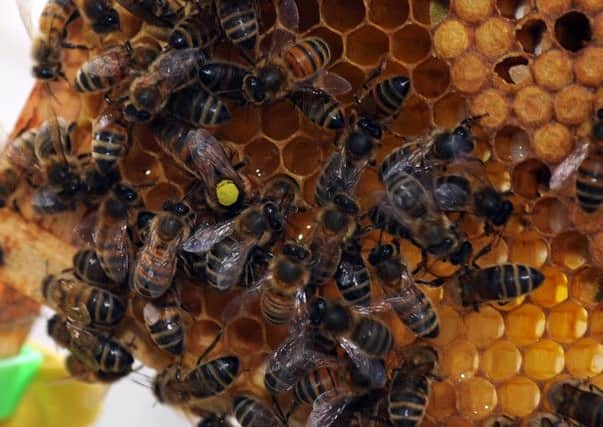The secret lives of bees


What’s surprised me is the life of the worker bees. I assumed that they were all pretty much the same. These girls were, I thought, constantly busy and spent their days working from dawn to dusk looking for pollen and nectar before making a bee line straight back home. Nothing could be further from the truth.
For a start - they don’t always work. If it’s wet the bees don’t fly. If it’s too windy the bees don’t fly. If it’s not warm enough the bees don’t fly. In fact a high proportion of them have never flown at all.
Advertisement
Hide AdAdvertisement
Hide AdQuite a lot of the bees in my hives have not got round to leaving their home yet. In their early days of adult life bees usually stay in the hive. The jobs they do vary enormously. Some of them wait around the entrance and collect food from incoming bees.
What happens next depends on need. Much of the supplies brought into the hive is reprocessed by specialist nurse bees and fed to the young. Other bees take some of the supplies and turn them into wax to produce the famous honeycomb structures. It takes six times as much energy for the bees to produce wax as it does to produce the same weight of honey.
Even when the home is built there’s other jobs to do. Some worker bees specialise in cleaning the hive while others spend days shivering to warm up the hive or fanning their wings to cool it down.
The workers aren’t directed by the queen. The workers themselves decide what jobs need doing. If more bees are needed for one job than another, the bees that need help will recruit others.
Advertisement
Hide AdAdvertisement
Hide AdExactly how worker bees make these decisions scientists don’t properly understand. We know they communicate via chemicals, by touching each other, and by dances and vibrations, and we know that they follow electrical signals. But how a collection of tiny individuals make a complex decision such as deciding the queen needs to be forced to fly off with a swarm is something computer programmers are studying in the hope it’ll help them design robots that can make intelligent choices.
As bees grow older they fly out into the world and their decision making becomes even more impressive. The hive sends the most experienced bees with the shortest life expectancies on food gathering missions. The outside world is a complex place and it’s hard to navigate on the basis of the vibrations sent out by their sisters dancing inside of a pitch black hive.
The bees that leave the hive don’t make a bee line back. They use a mixture of the angle of the sun, the Earth’s gravitational field and landmarks. This means they can get lost. In a busy apiary up to 20 per cent can end up in the wrong hive because they didn’t recognise home.
It takes skill for a bee to locate a plant with nectar or pollen, load up a sack on her back legs with food and fly back through gusts of wind to a small home which can be up to three miles away. Along the way there’s ample opportunities for hungry birds to pick up their own dinner.
Advertisement
Hide AdAdvertisement
Hide AdThe forager bees get worn out pretty quickly. Four weeks would be a long time to survive and death from exhaustion after only a couple of weeks would be likely.
Each teaspoon of honey is said to represent 154 trips out of the hive by individual bees. Producing 1lb of honey involves the equivalent of a bee flying three times around the world. Given it’s taken such subtle organisation of so much labour to produce small amounts of honey it seems such a shame to take it away from them. Then again - it is very nice on toast!